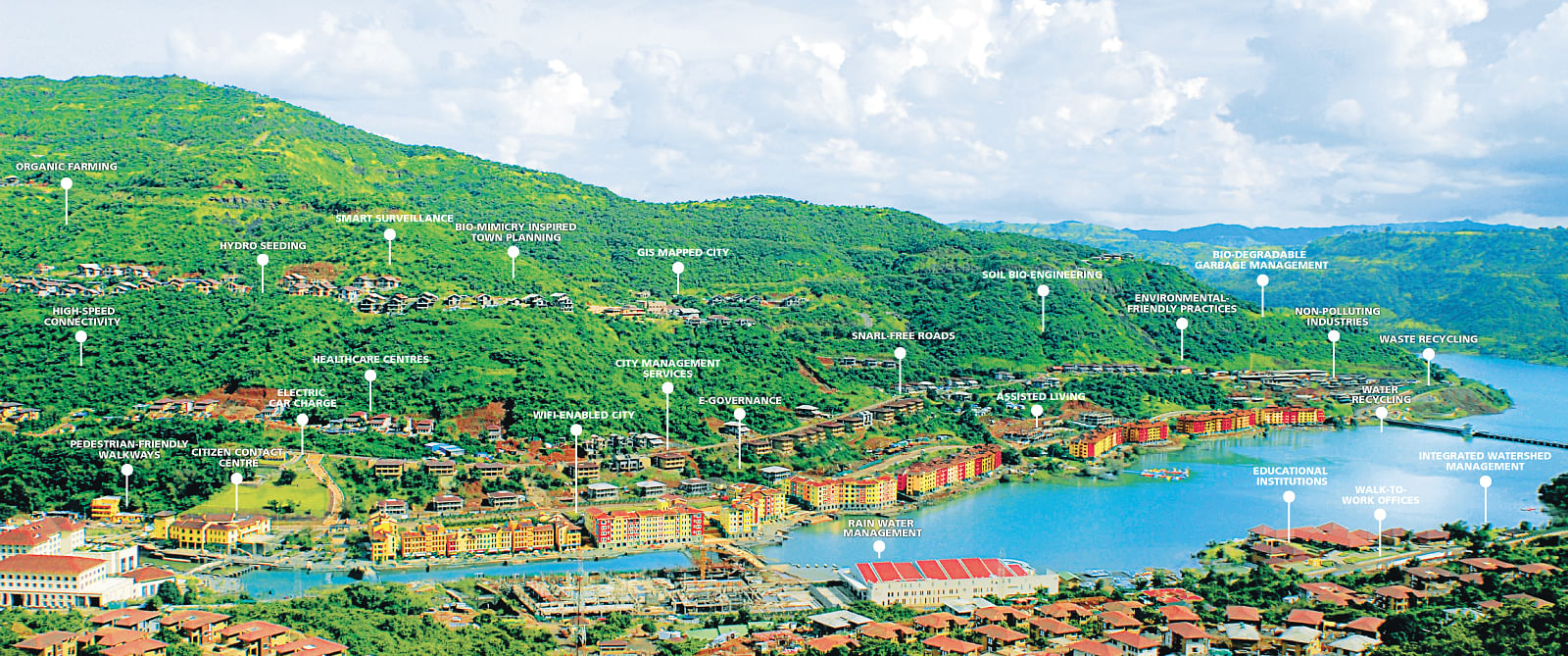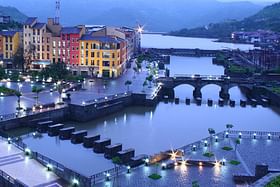Despite an exciting start to the Lavasa City development, the project was crippled with policy inconsistencies.
There were claims of land displacement, bypassing planning laws, and concerns about water shortages for Pune’s growing population downstream.
One of India’s first city imagined and planned to be executed and run by a private entity — Lavasa — in Maharashtra, has recently been in news again, concerning its massive financial woes and attempts for revival.
In this significant development, the National Company Law Tribunal (NCLT) has reached a verdict on the Lavasa City project, awarding it to the Darwin Platform Group, a prominent Mumbai-based business conglomerate, as per a Business Today report.
Back in 2021, the Darwin Platform Infrastructure Limited (DPIL) received support from the Committee of Creditors (CoC) for its bid to take over Lavasa hill city.
The plan submitted by DPIL received 97 per cent of the votes from the CoC — which proposed a total resolution plan of Rs 1,814 crore. At least 66 per cent of votes are required for bid approval.
After CoC approval, the bid had to be cleared by the NCLT.
This backing offered hope to numerous investors who had been eagerly anticipating the completion of this ambitious project after it faced a decade of stagnation, leading to unsuccessful development and eventual bankruptcy.
The City Imagined
The one of its kind city — this unique project spread over 20,000 acres in the Mulshi and Velhe regions of Pune district.
It was conceptualised and developed by Lavasa Corporation Limited, a subsidiary of Hindustan Construction Company (HCC). The city’s construction commenced in the early 2000s.
HCC holds the majority stake in LCC, amounting to 68 per cent, while the Avantha Group owning 17 per cent, Venkateshwara Hatcheries holding 8.8 per cent, and the Maniar family with 6.2 per cent.
The masterplan of Lavasa incorporates the principles of new urbanism, aiming to create a well-organised city — spread accross areas from 18 villages, situated in the ecologically diverse and abundant Western Ghats region of Maharashtra.
The goal was to create a world-class hill city that stimulates economic growth in an underdeveloped region, while aiming to set new standards in planning, construction, and service delivery.
HOK, the firm responsible for the design, stated that biomimesis — design inspired by the science of natural systems and structures, guided the masterplan.
It had been designed to accommodate a permanent population of approximately three lakh residents and anticipate a yearly tourist influx of 20 lakh.
The city, when completed, will have 5 towns – Dasve, Mugaon, Dhamanohol, Sakhari-Wadavali and the Central Business District (CBD).
The project’s origin was attributed to Nationalist Congress Party (NCP) leader Sharad Pawar and his son-in-law, Sadanand Sule, even owned a 12.7 per cent stake in the project until 2007, as per several reports.
Despite an exciting start to development and construction, the project has faced various obstacles, including policy inconsistencies and allegations of wrongdoing by activist groups.
The promoters and developers of Lavasa were accused of bending rules, and ignoring environmental statutes during the construction process.

What went wrong?
Lavasa City had been mired in controversy and experienced a setback of three years, starting with environmental law violations.
Further, there were claims of land displacement, bypassing planning laws, and concerns about water shortages for Pune’s growing population downstream.
Construction work at Lavasa was on full swing till 25 November 2010, when the Union Ministry of Environment and Forests (MoEF) issued a stop-work order due to the company’s failure to obtain environmental clearance from the ministry.
Lavasa Corporation Limited (LCL) had proceeded with the project based on clearance from Maharashtra’s environment department.
The MoEF intervened following a public interest petition filed by the National Alliance of People’s Movements (NAPM) in the Mumbai High Court.
LCL challenged the MoEF’s order in court, arguing that they had obtained the necessary clearances from the state and that the ministry lacked jurisdiction over the project.
However, it was later revealed that the company did not apply to the Centre for clearance under the Environmental Impact Assessment (EIA) notification of 1994, which was mandatory for tourism-related projects for projects at an elevation of more than 1,000m from sea level, involving investment of over Rs 5 crore.
Meanwhile, 58 hectares of Lavasa city were above 1,000m height, and the project cost exceeded Rs 5 crore, requiring LCL to seek clearance from the Centre.
Additionally, the project faced allegations of encroaching on tribal land.
The land used for the project was originally owned by adivasis and former landless individuals from 18 villages in Pune district, who received it as part of state land reforms in the 1960s.
In June 2008, LCL was given Special Planning Authority (SPA) status, granting it the power to approve its own plans and revise the city’s master plan.
Lavasa structures, originally limited to two storeys, were increased to six storeys by transferring the FSI from the slopes to the valley.
The status of a SPA is one that is usually reserved for government organisations. in 2017, the Maharashtra government revoked Lavasa’s SPA status, placing it under PMRDA’s supervision.
Downfall of the Retreat City
Following these actions, plans for this retreat city from modern India, faced major setbacks — which included holding a possible IPO of the developer.
This led to a significant decline in cash flow, and attempts to attract equity investors were unsuccessful due to concerns over government intervention.
Though construction resumed about a year later after obtaining approvals for 21 sq km, but by then — the project had encountered numerous difficulties.
HCC also said that the Ministry of Environment’s notification to stop work for jurisdictional reasons, not environmental infractions, severely impacted the project.
“Furthermore, delay in implementation of an approved Joint Lenders Forum (JLF) financial restructuring plan resulted in the project remaining stalled for a further 2.5 years”.
With lack of working capital, Lavasa’s operations gradually came to a standstill, which in turn prompted investors and partners to step back.
In 2018, the case was brought before the National Company Law Tribunal (NCLT). In August of that year, the NCLT accepted a petition to declare Lavasa Corporation bankrupt.
The acceptance of the application made by HCC — sought to initiate insolvency proceedings against Lavasa Corporation under the Insolvency and Bankruptcy Code (IBC).
Leaving Indian Banks and Investors in Turmoil
The substantial financial burden emerged with outstanding loans amounting to Rs 6,000 crore.
The project’s failure has led to significant losses for Indian lenders, with Lavasa defaulting on dues to bondholders and delaying repayments to other creditors, including banks.
Presently, Lavasa is an incomplete shell of a city housing approximately 10,000 residents. While it attracts tourists, many apartments have been bought by wealthy urbanites as second homes.
However, the envisioned mixed community liveability remains aspirational, with workers often stating their temporary employment intentions due to the lack of schools and community facilities.
Beyond the current residents’ challenges, those who invested their life savings or borrowed money to buy property in Lavasa face uncertainty as the city may never reach completion.
Efforts underway to salvage this ambitious city project, and its success could serve as a catalyst for similar projects across the country.
The recent positive development brings hope and relief, rekindling the possibility of making Lavasa a reality and supporting the investors who have been affected.
Ajay Harinath Singh of DPIL, in an official statement said, “Our group is committed to nation-building and our vision is perfectly aligned with the PM and the Home Minister’s mission to make India an economic superpower. The NCLT has entrusted us with a challenging task to develop an ambitious world-class smart city in the country. The verdict would reinforce our commitment to nation-building.”
Lavasa, he outlined, is now on the cusp of a remarkable resurgence. “DPIL is committed to executing the plan as per the schedule proposed to the CoC. We are very eager to revitalize this ambitious project”.


